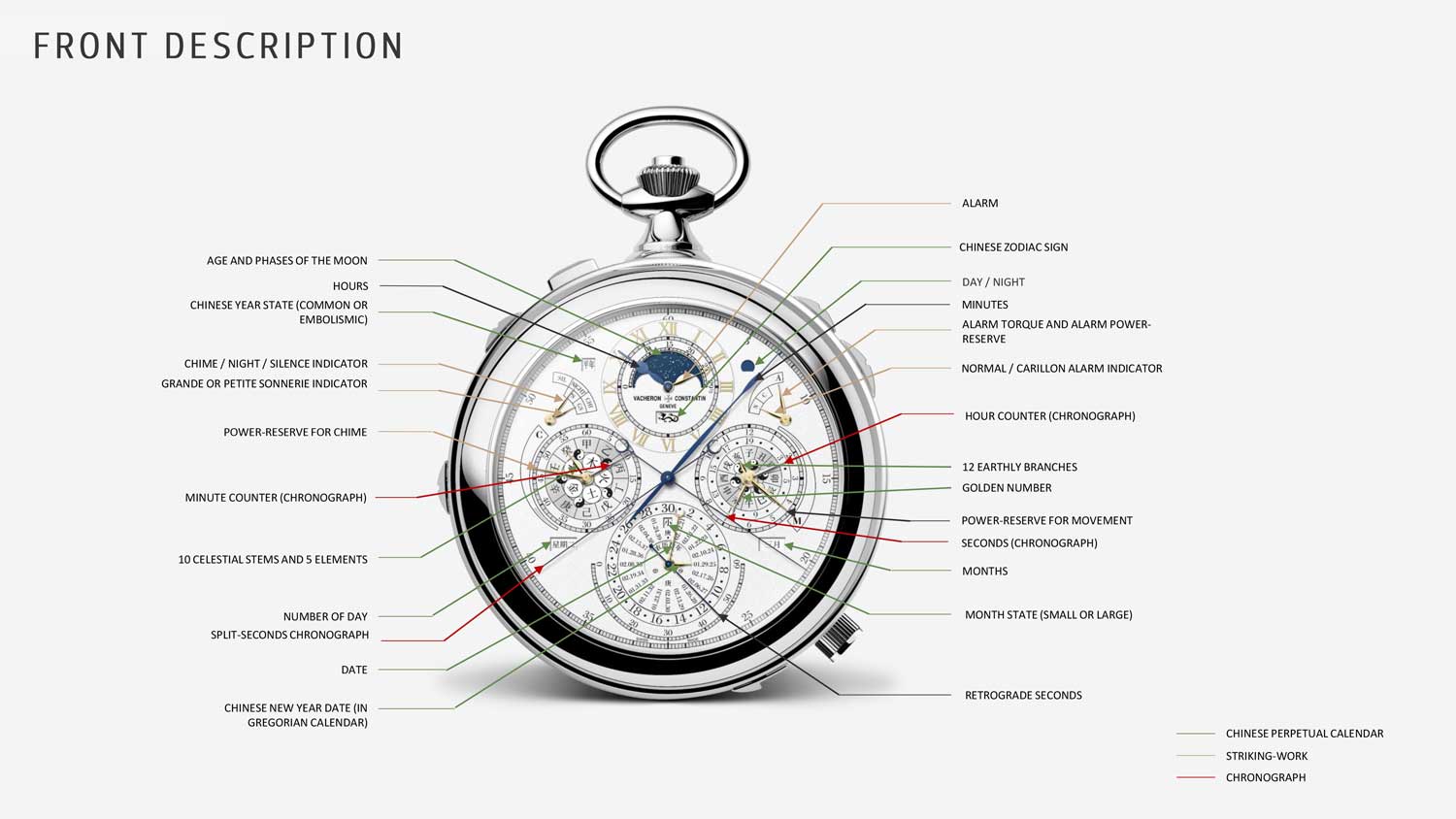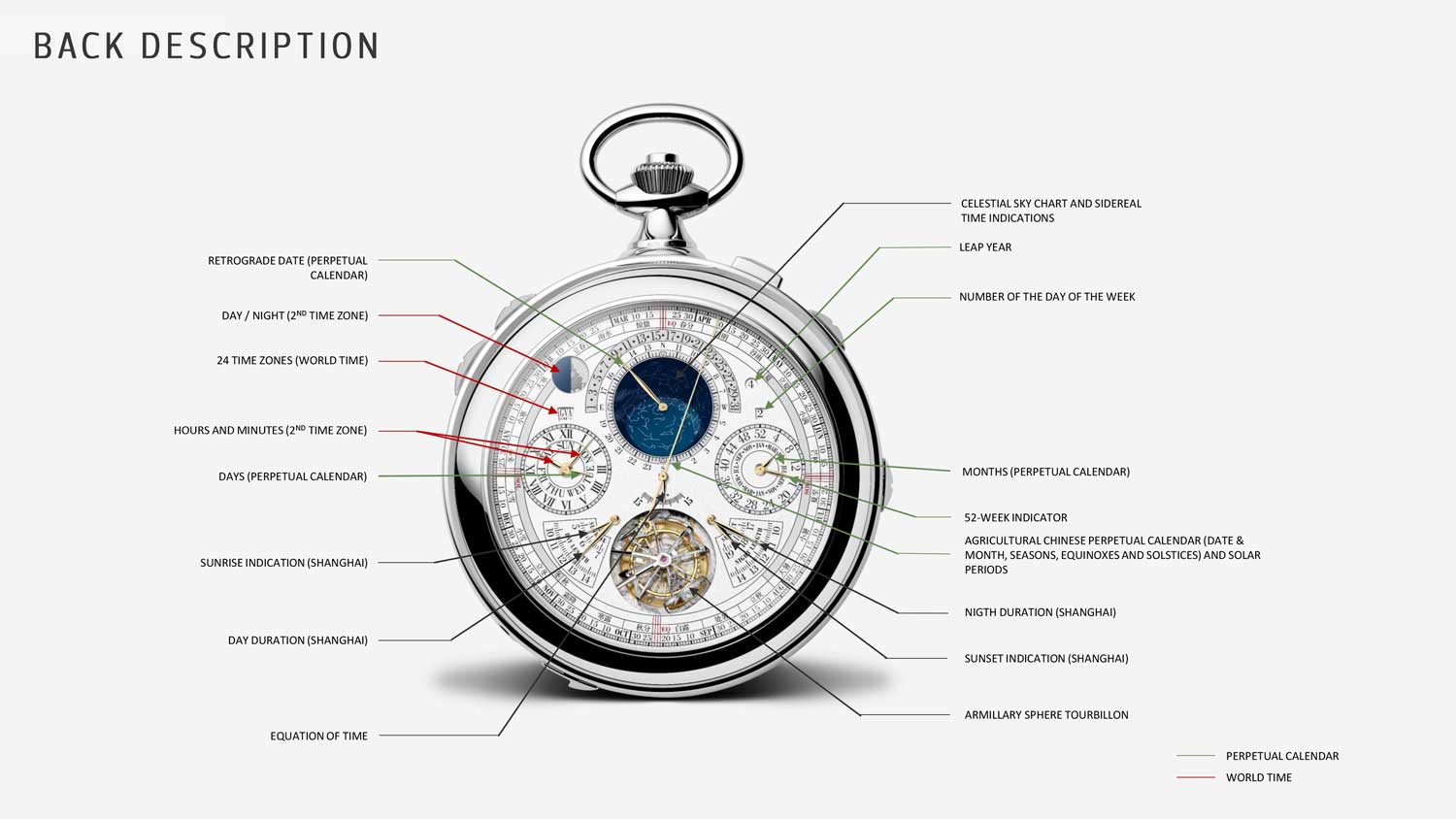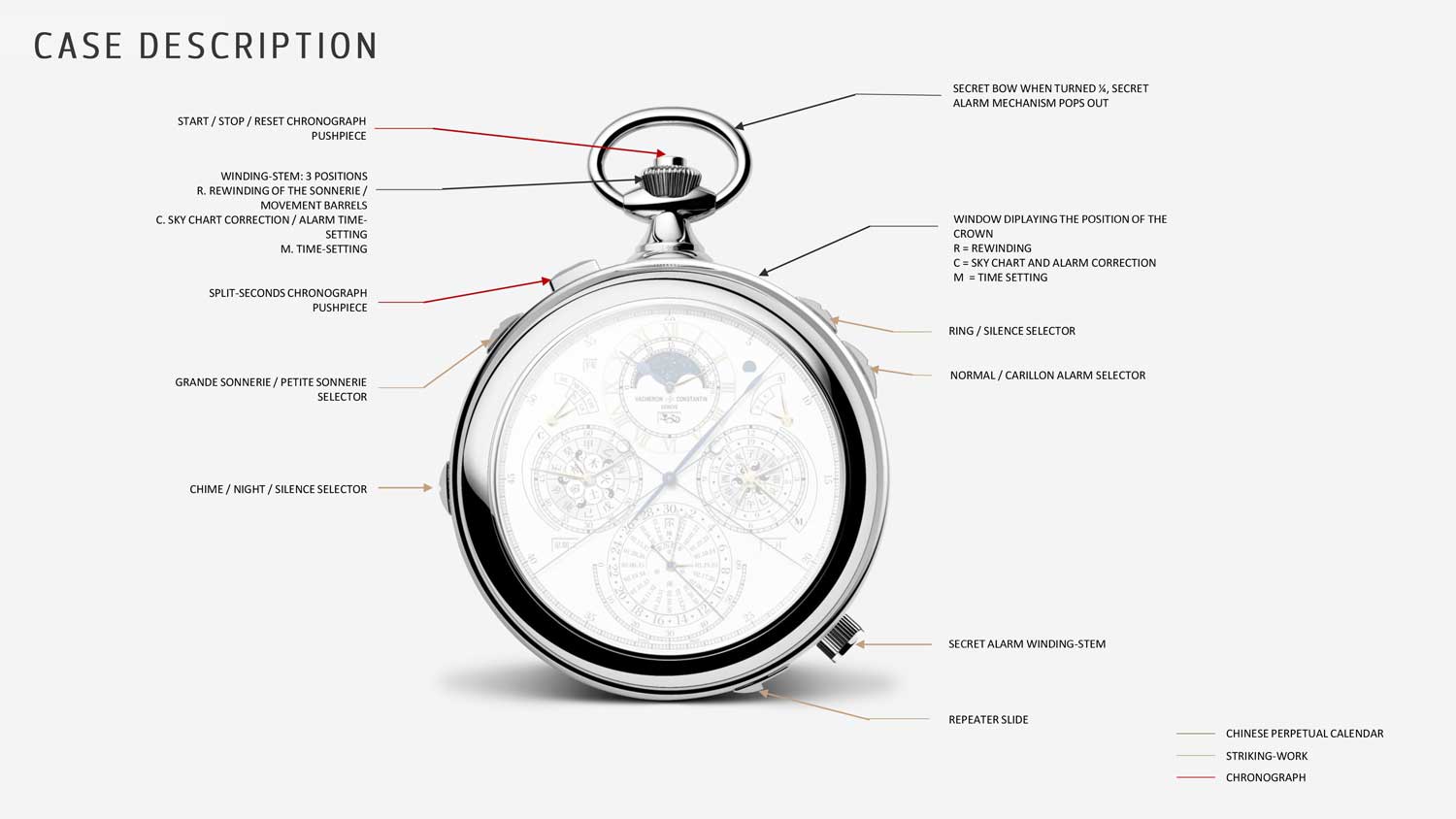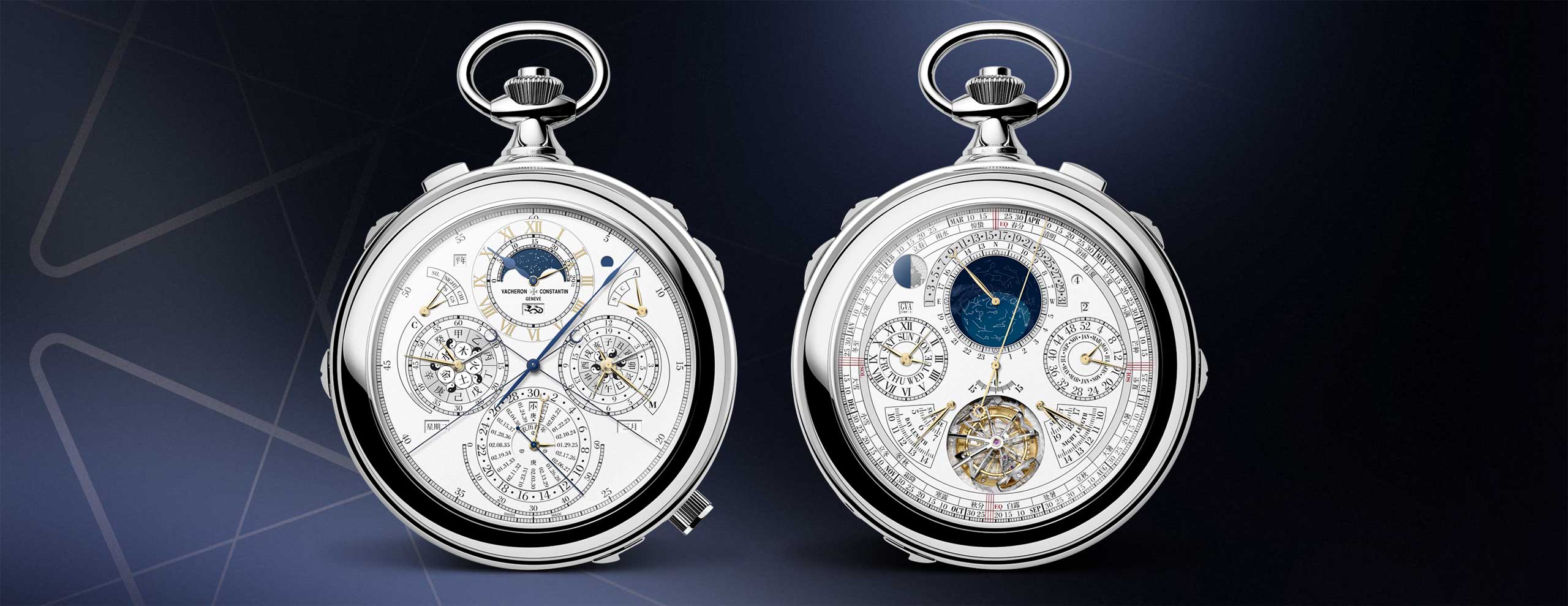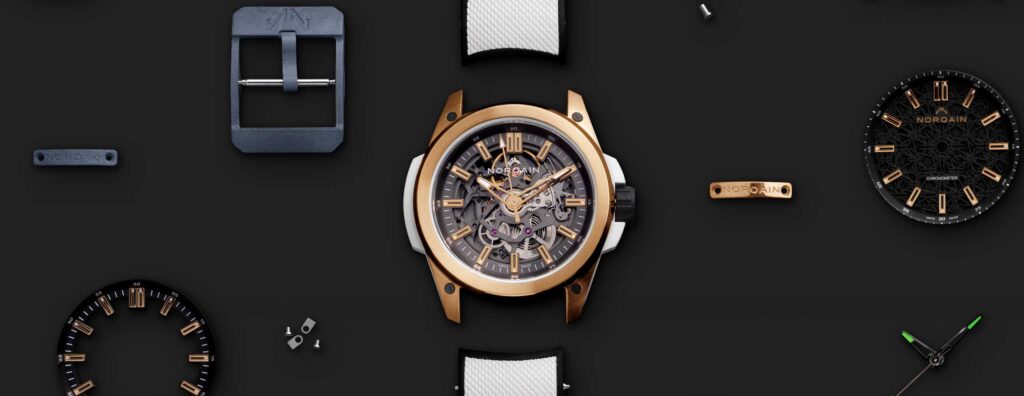An astounding achievement boasting 63 complications and the world’s first Chinese perpetual calendar
It doesn’t take long amidst the deluge of releases at Watches & Wonders to surmise that 2024 is a year of high complications. Yet there is a watch that redefines complicated watchmaking and that is the Vacheron Constantin Les Cabinotiers The Berkley Grand Complication. According to the brand, the watch has been in development for 11 years including a year devoted solely to its assembly. Commissioned by an American collector and philanthropist, its creation was overseen by the same trio of master watchmakers who spearheaded the development of the reference 57260 in 2015.
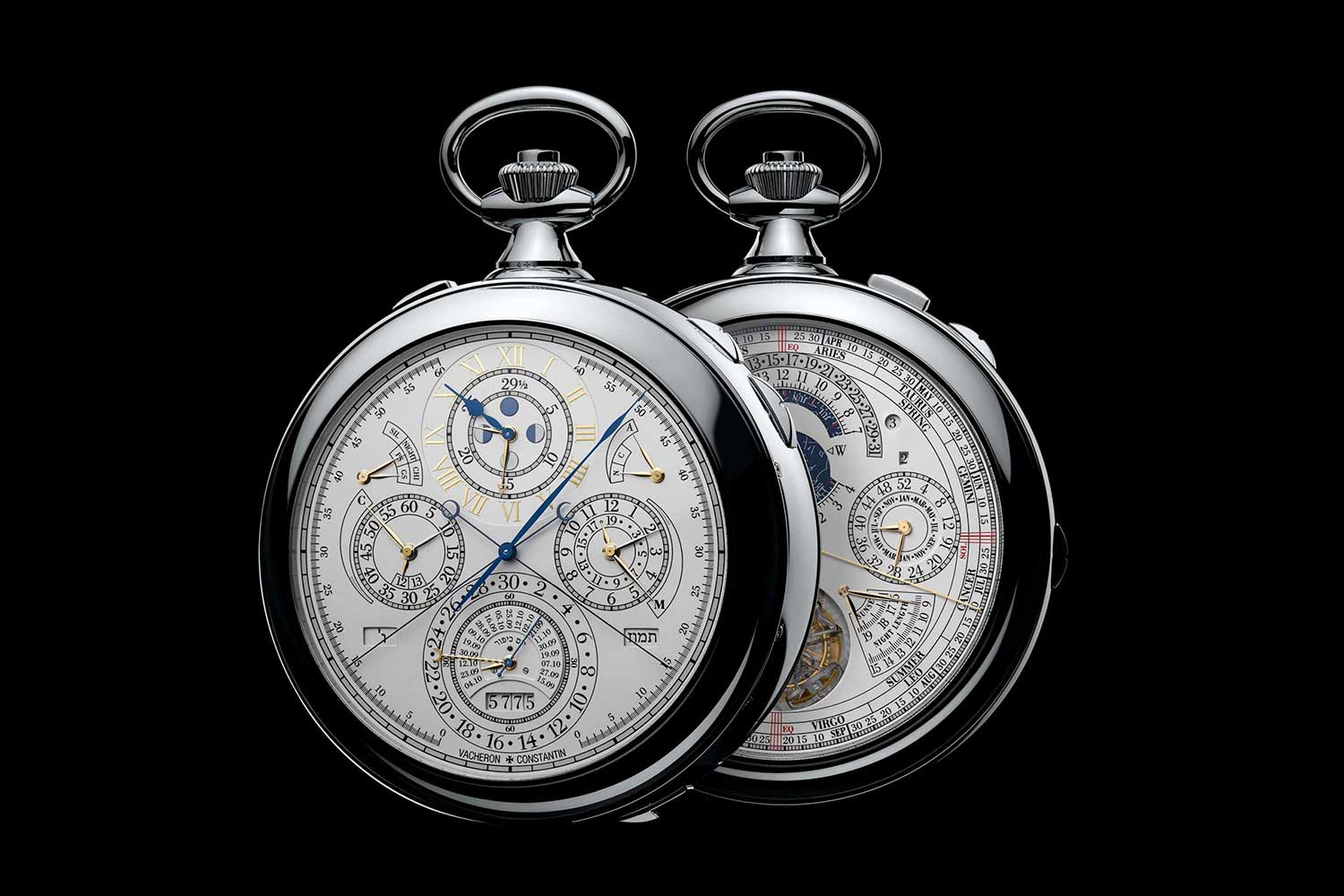
Vacheron Constantin Ref 57260
With a staggering total of 63 complications that span calendar, timing and chiming, the Les Cabinotiers The Berkley Grand Complication surpasses the record already held by the reference 57260. However, the watch is far more than just numbers, it is completely unique in that it is the first ever Chinese perpetual calendar. While there have been a handful of Chinese calendar watches, none of them are perpetual as it is forbiddingly difficult, impossible even, to devise a gear train for a calendar that is inherently unpredictable with numerous irregularities along the cycle.
Achieving the unachievable: A Perpetual Chinese Calendar
The natural foundations of timekeeping—day, month, and year— stem from the Earth’s rotation on its own axis, the moon’s orbit around the Earth, and the Earth’s orbit around the Sun respectively. However, these natural units are not whole numbers, which spurred the creation and evolution of calendars.
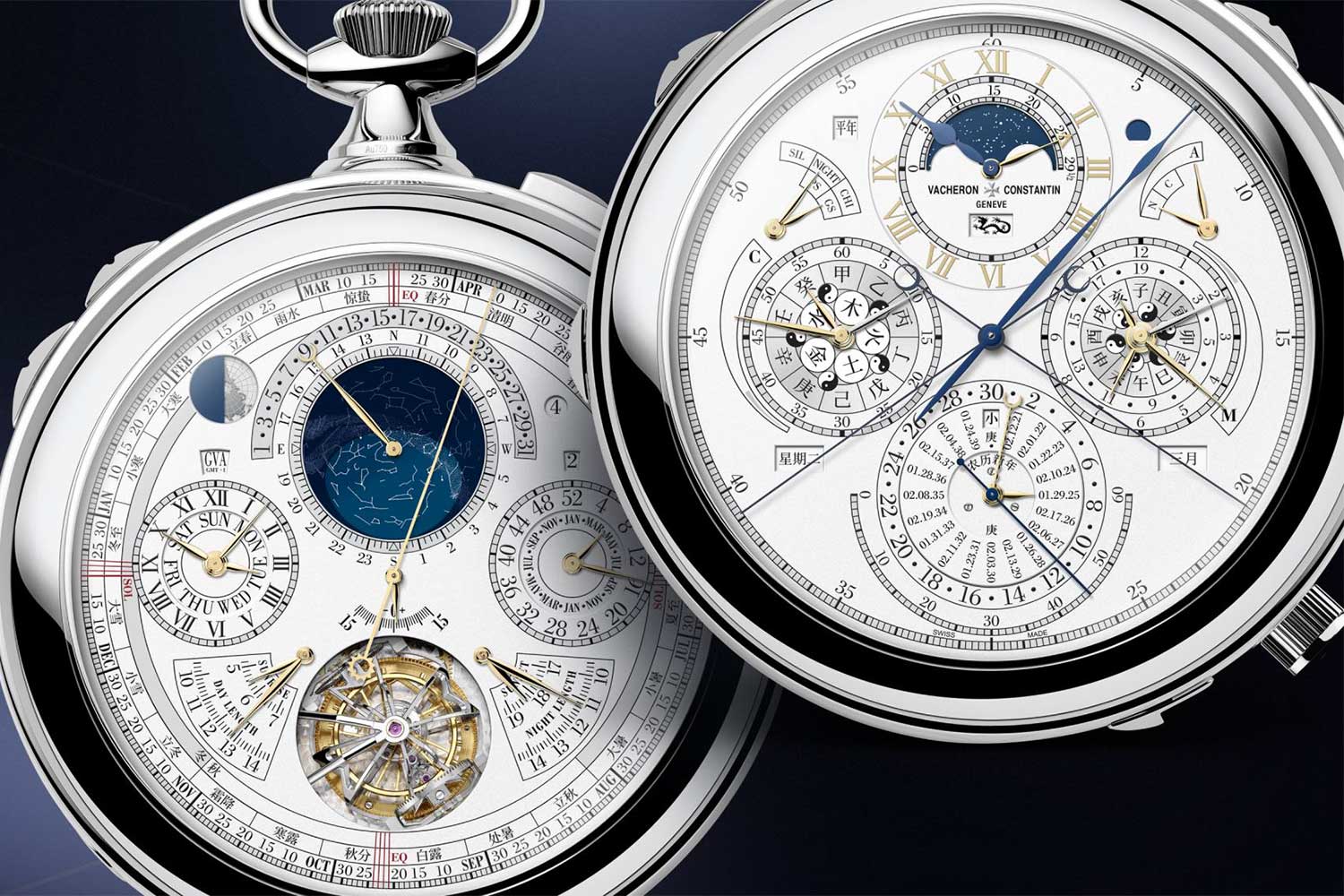
Vacheron Constantin Les Cabinotiers The Berkley Grand Complication
The Gregorian calendar disregards the lunar cycle and derives the units for measuring time primarily from the Earth’s orbit around the Sun and the resulting seasonal changes, essentially subordinating the length of months to the solar year. The Islamic calendar, conversely, derives its units solely from the phases of the moon’s orbit around the Earth, aligning year lengths with lunar months.
A lunisolar calendar like the Chinese calendar presents a nuanced approach to timekeeping, blending elements of both lunar and solar cycles. The Chinese calendar comprises of 12 lunar months that irregularly comprise of 29 or 30 days, based on an approximation of 29.53 days for each month. A lunar year is thus approximately 354.36 days, drifting in relation to the solar year and creating seasonal misalignments. By contrast, solar years consist of approximately 365.25 days, maintaining synchronization with the seasons but disregarding lunar phases.
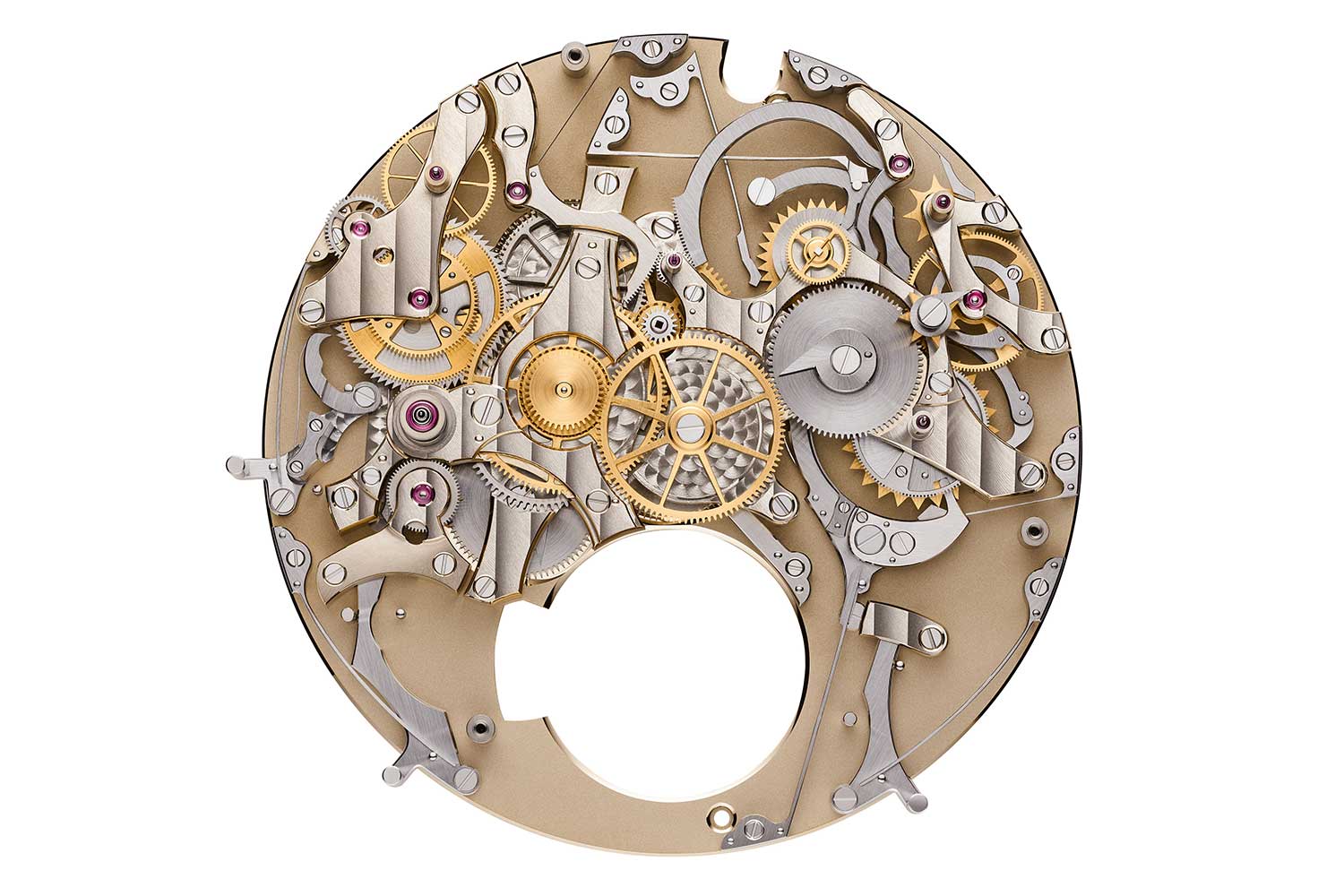
Plate252- Gregorian Perpetual Calendar
To synchronize lunar months with solar years, it is necessary to mitigate the fractional difference between the length of a lunar month and the length of a solar year. This fractional difference accumulates over time, resulting in occasional misalignments between lunar and solar cycles. While this is ultimately unsolvable, the goal of the calendar designer is to minimise the discrepancy as much as possible.

Plate352 - Chinese Perpetual Calendar
The Metonic cycle, named after the ancient Greek astronomer Meton of Athens who first described it, provides a solution to this problem by establishing a period during which a whole number of lunar months will accumulate without the need for fractional adjustments. Specifically, the Metonic cycle spans 19 years, which corresponds to 235 lunar months.
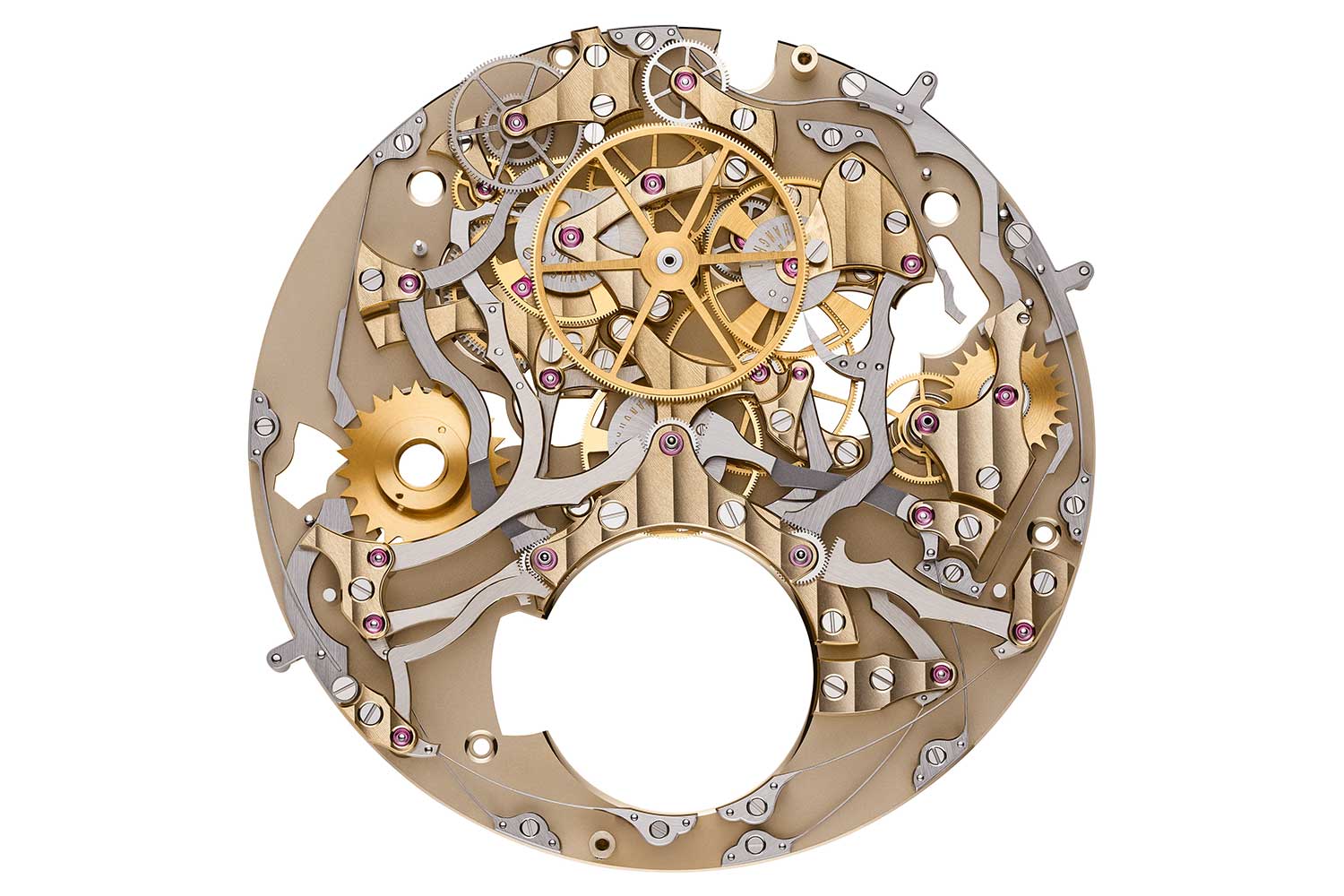
Plate 552 - Astronomical Functions
Approximately every two to three years within the Metonic cycle, the Chinese calendar adds a 13th intercalary month or embolismic month to ensure synchronization with the solar year. In other words, over the course of 19 years, there are about seven instances where a 13th month is added to the calendar to align it with the solar year. But despite these efforts, the system remains irregular as there is no fixed cycle for the addition of an intercalary month. The exact timing of the Chinese New Year still varies within a range of dates, influenced by the interplay between lunar months and the solar year, resulting in a fluctuation between January 21st and February 21st, without adhering to a fixed cycle.
Christian Selmoni, the Style and Heritage Director at Vacheron Constantin explains, “There are observatories around the world, such as the Paris Observatory that have made simulations of the Chinese calendar and the dates of Chinese New Year, taking into account all the corrections, until the year 2944.”
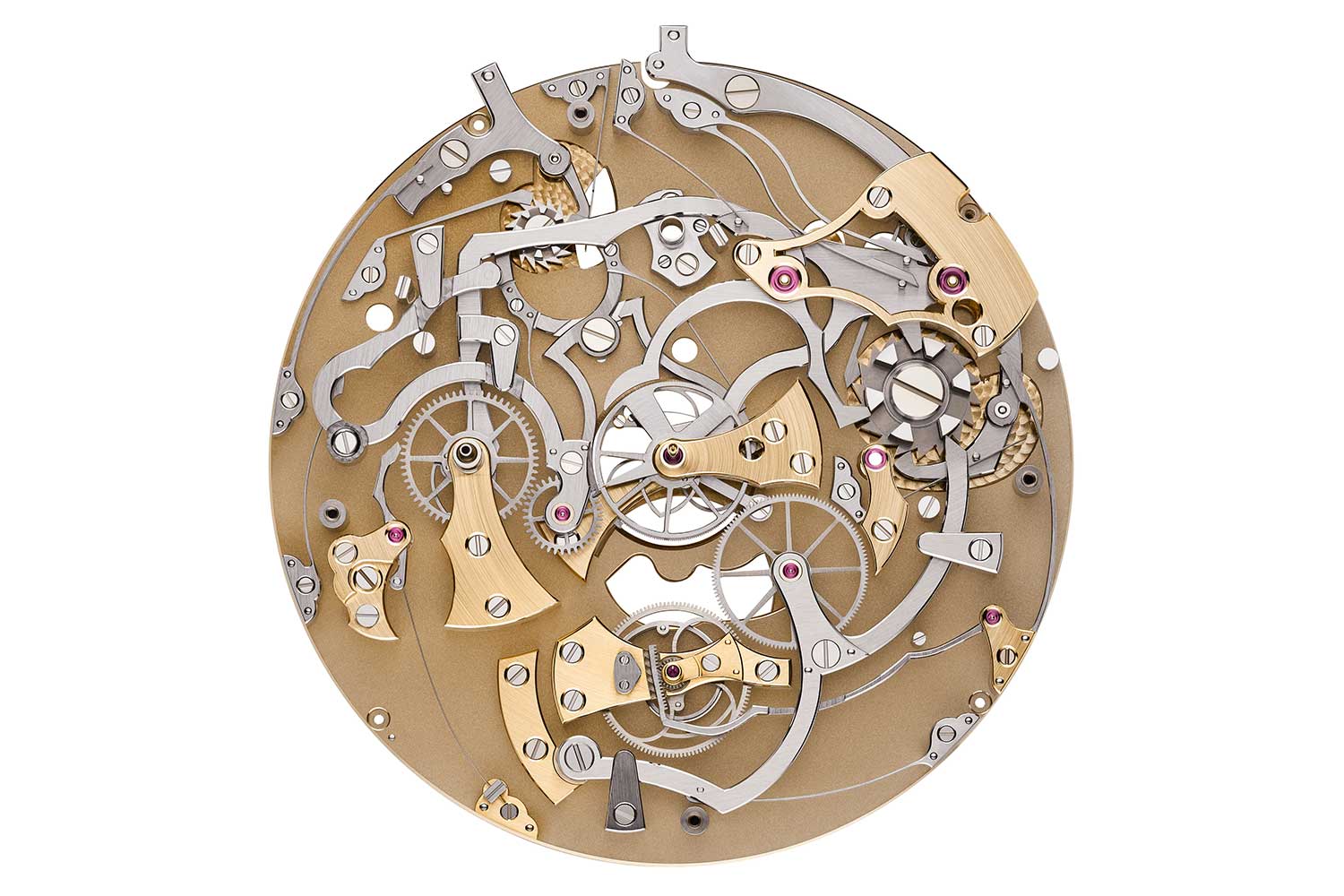
Plate152 - Split Seconds Chronograph
The brand describes the solution as follows, “The three watchmakers first had to model the calendar in algorithms before transcribing them into a mechanism programmed until the year 2200. To achieve this, they devised three mechanical ‘brains’ to controlling the cams and gears on one of the movement’s two additional mechanisms on the front side. Broadly speaking, each of them “drives” one of the calendar’s components: namely the lunar cycle, the solar cycle and the Metonic cycle.”
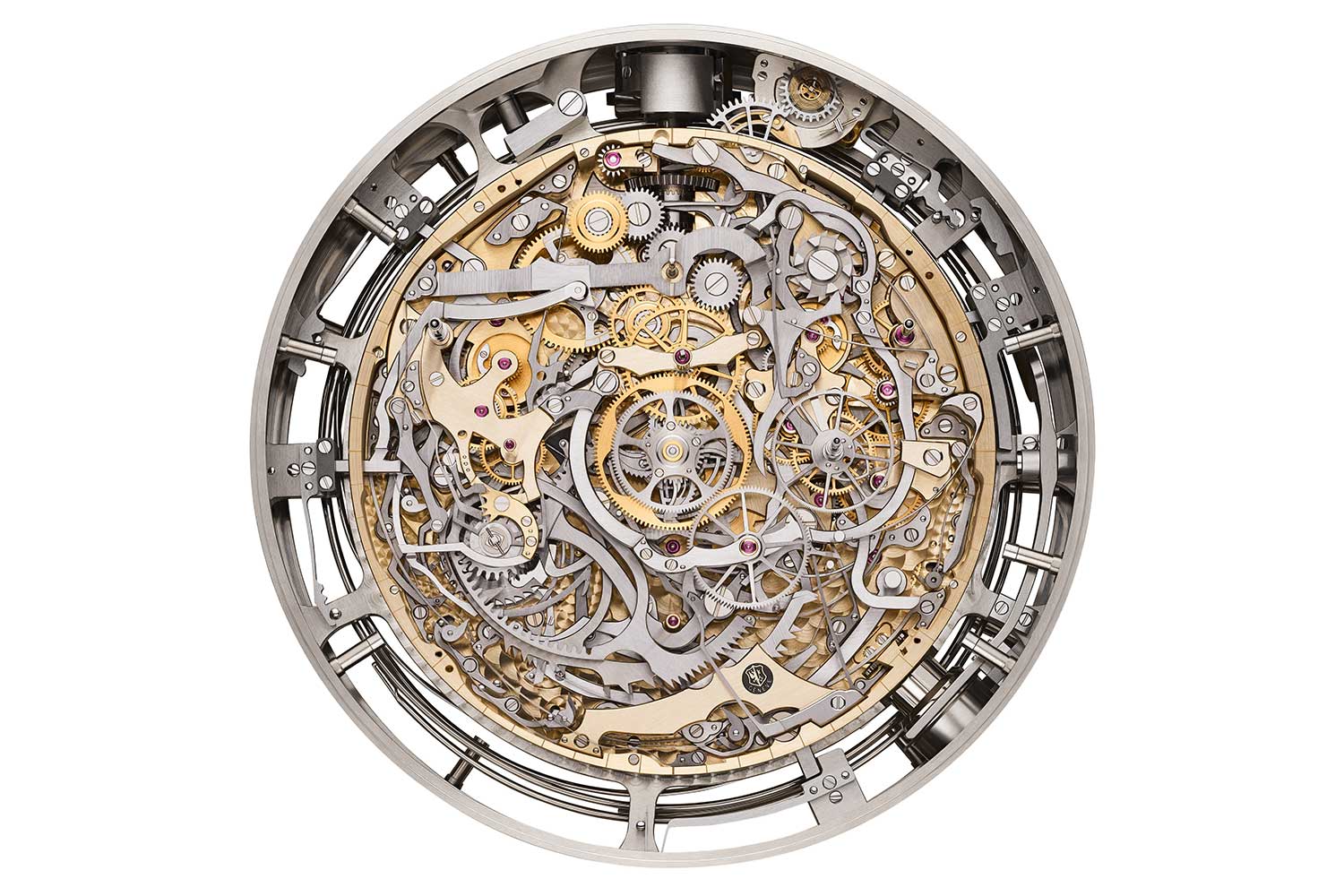
Caliber 3752 - Face Side
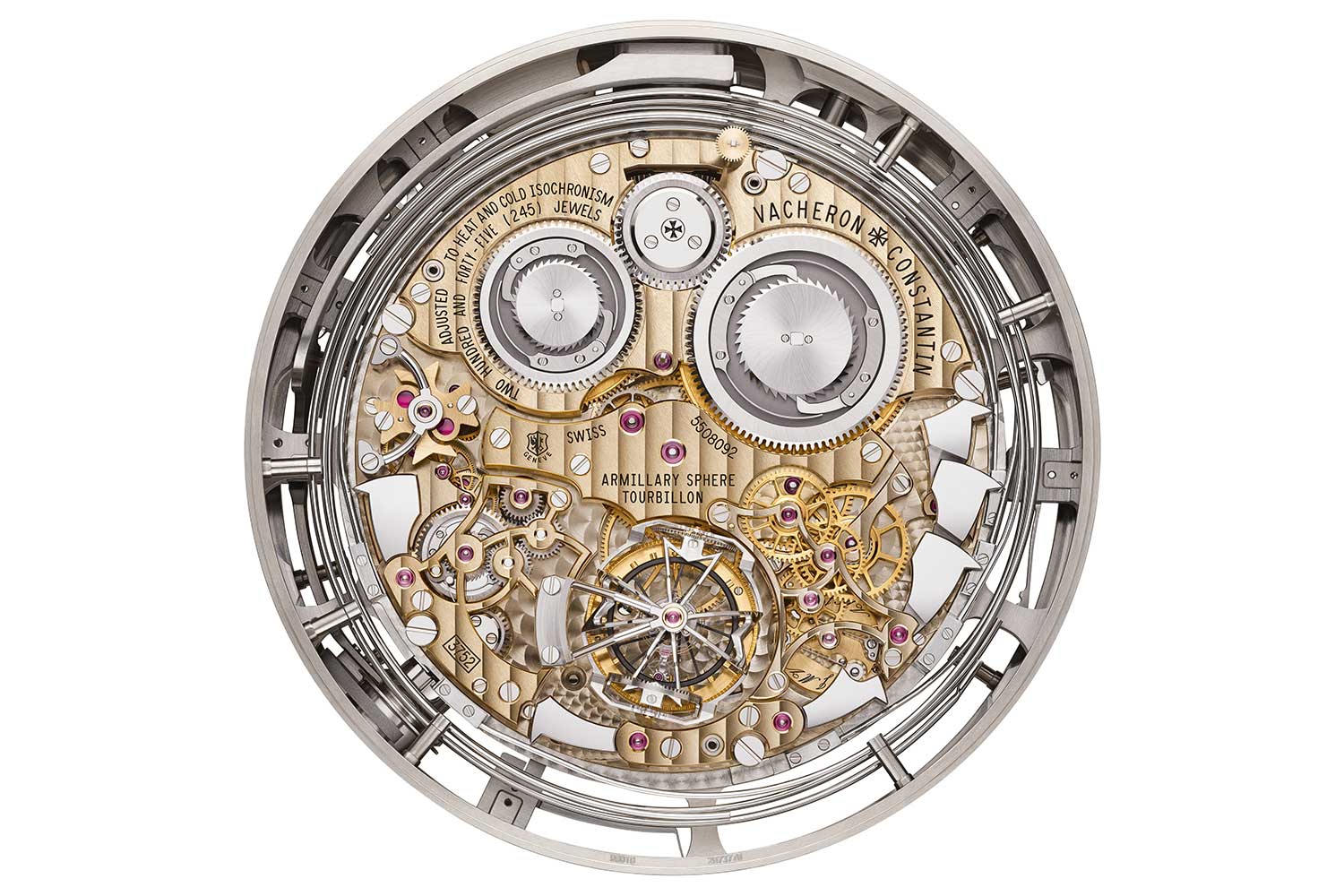
Caliber 3752 - Back side
“After 2200, a wheel at the periphery of the movement has to be replaced,” Selmoni explains. “No patent has so far been filed for this model, for a very simple reason: the watchmakers at Vacheron Constantin did not wish to reveal how they managed to transpose the immense complexity of the Chinese calendar into a ‘perpetual’ horological configuration” While the exact method is yet disclosed and may never be, the lunisolar Hebraic calendar was one of the defining complications in the reference 57260 and the fundamental principles behind the solutions would likely be comparable.
The dates of Chinese New Year for the next 20 years are displayed on the sub-dial at six o’clock, and the watch was accompanied by eight additional discs bearing dates of CNY until the year 2200.
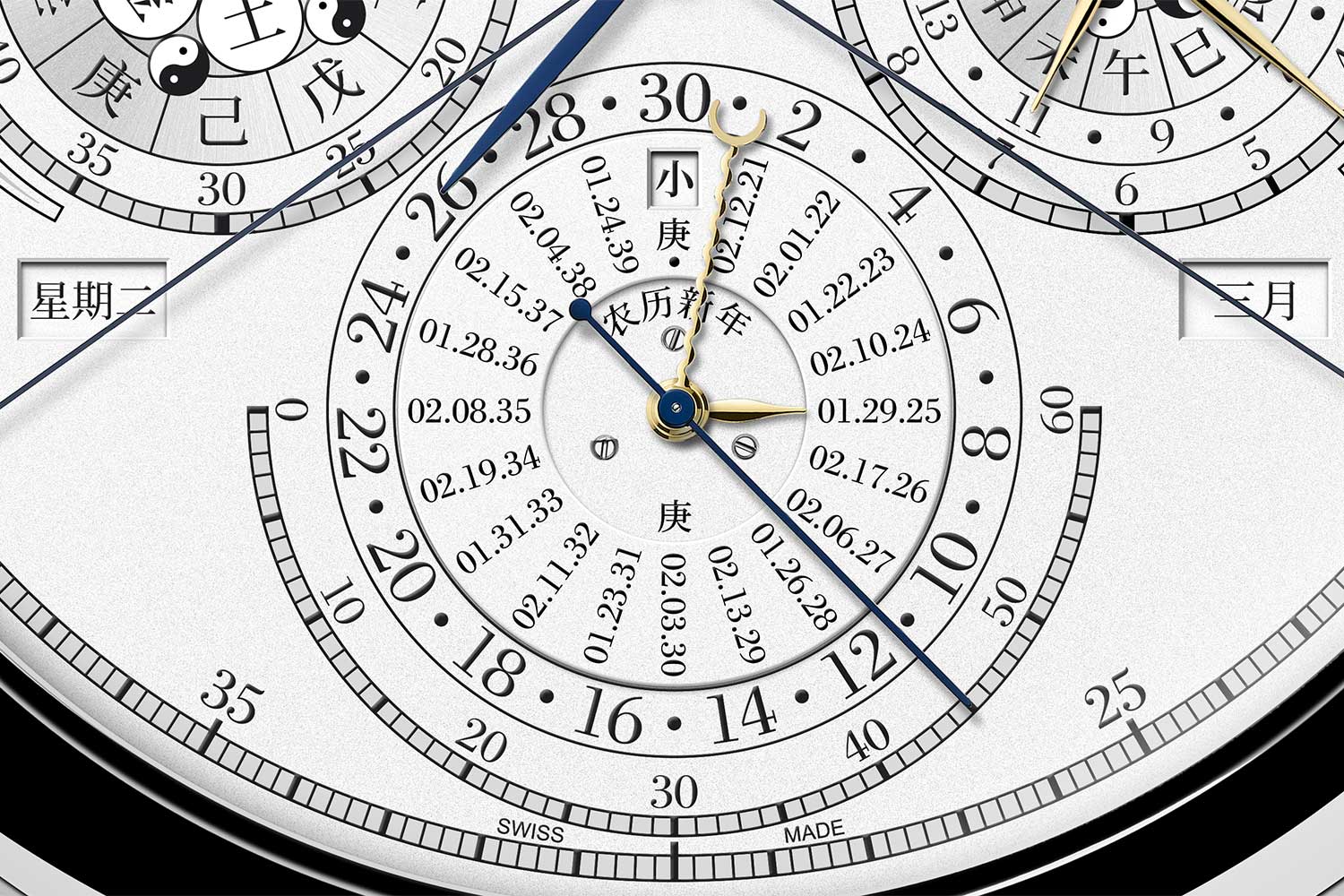
Display for the next 20 years of Chinese New Year
But on top of that, separate but integral to the Chinese calendar is the sexagesimal cycle, which fortunately is fixed and follows a predictable 60-year cycle. This system combines the ten celestial stems and twelve earthly branches, resulting in 60 unique combinations. While primarily used for marking years, it extends to organizing months, days, and hours. The ten celestial stems are associated with the five elements and yin-yang polarity, while the twelve earthly branches correspond to the Chinese zodiac signs. This intricate system has influenced Chinese civilization for millennia, shaping cultural practices, societal structures, and historical events. The ten celestial stems and 12 earthly branches are divided into two sub-dials at nine and three o’clock respectively, progressing by one step each year.
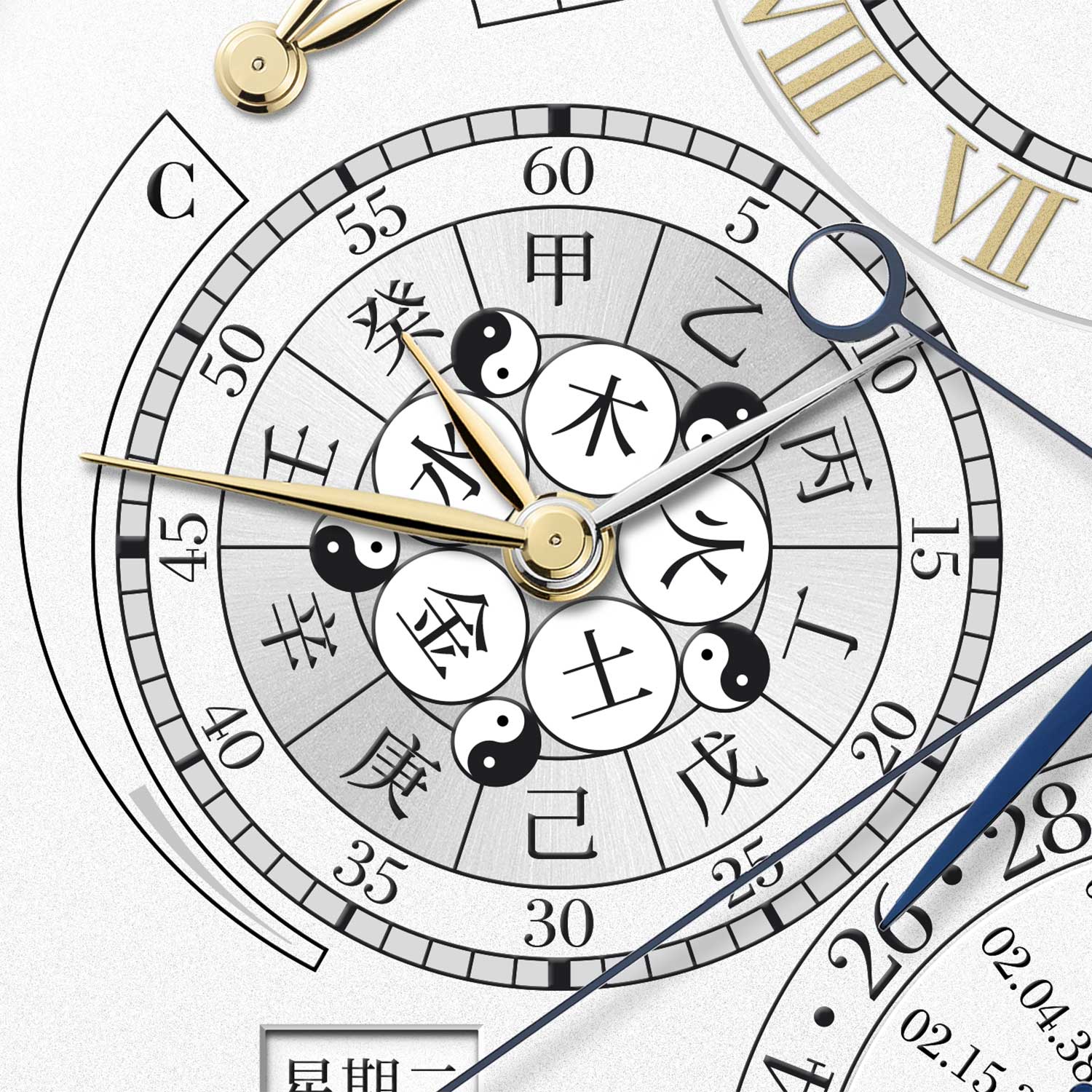
The sexagesimal cycle
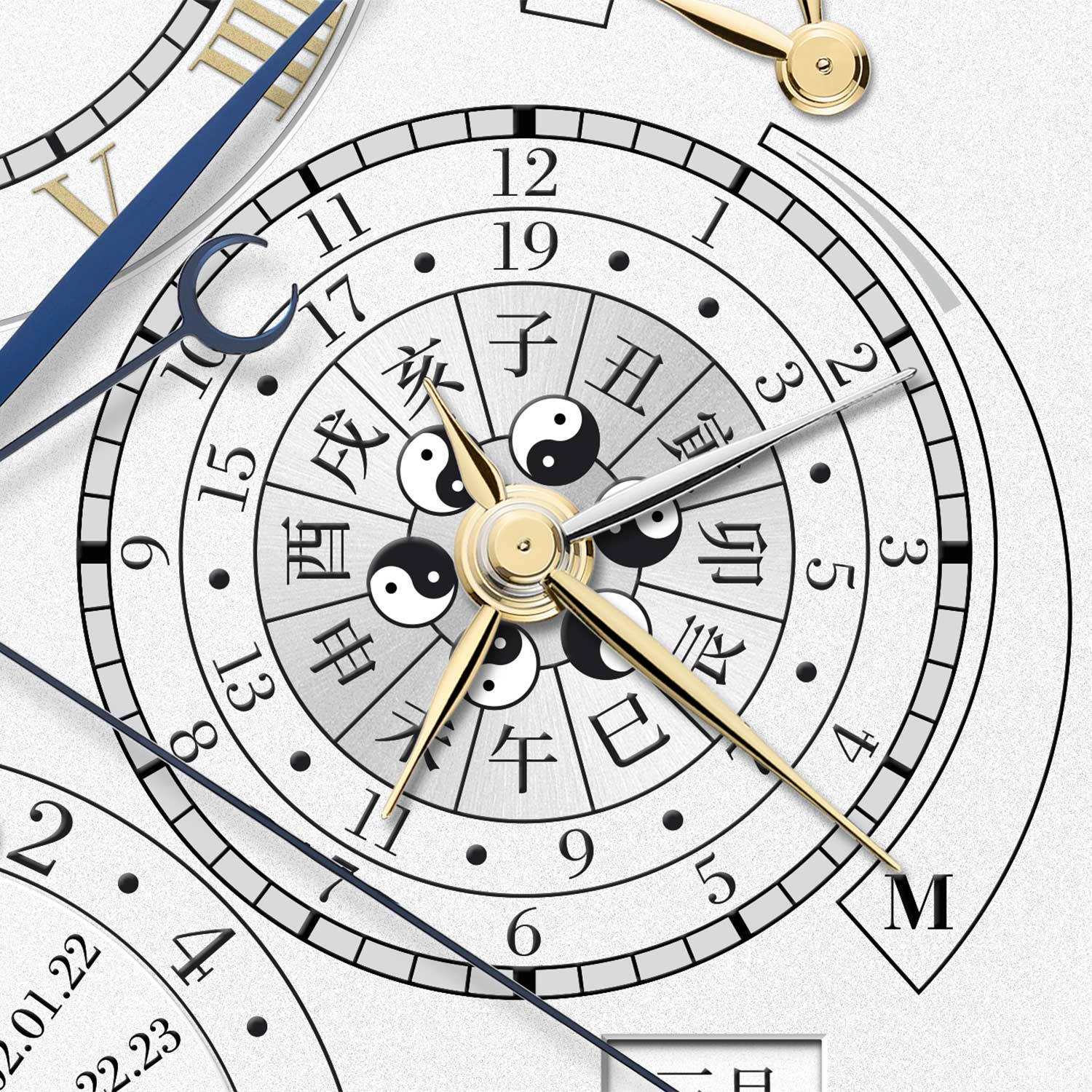
Twelve Chinese Zodiac signs
For agricultural purposes, a year in the Chinese calendar is also divided into 24 solar terms based on the Sun’s position along the ecliptic. Additionally, observing the occurrence of solar terms within each lunar month plays a role in determining when to insert an intercalary month. In a regular lunar year, the presence of both “Zhong qi” and “Jie qi” within each lunar month signifies the proper alignment of the lunar calendar with the solar cycle. However, if a lunar month lacks one term, it indicates a deviation, prompting the insertion of an intercalary month. The 24 solar terms, ranging from Li Chun (the start of spring) to Da Han (major cold), are displayed on the rear of the watch, indicated by a central hand, along with the month lengths, seasons, solstices and equinoxes.

The 24 solar terms
The hours is indicated on a sub-dial at 12 o’clock, the minutes is indicated with a blued central hand and the seconds on retrograde scale at six o’clock. Additionally, the hours sub-dial shows the age and phase of the moon which accumulates a day of error in 1027 years. The watch is also a monopusher split seconds chronograph with the 10-stem and 12 branch sub-dials doubling as the minute and hour counters respectively. It has a traditional horizontal clutch and is controlled by three column wheels – one for the central chronograph hand, one for the split hand and one for the 12 hour counter. While the reference 57260 had a retrograde seconds hands for the rattrapante, The Berkley employs a traditional display which is more intuitive considering the wealth of information on offer.
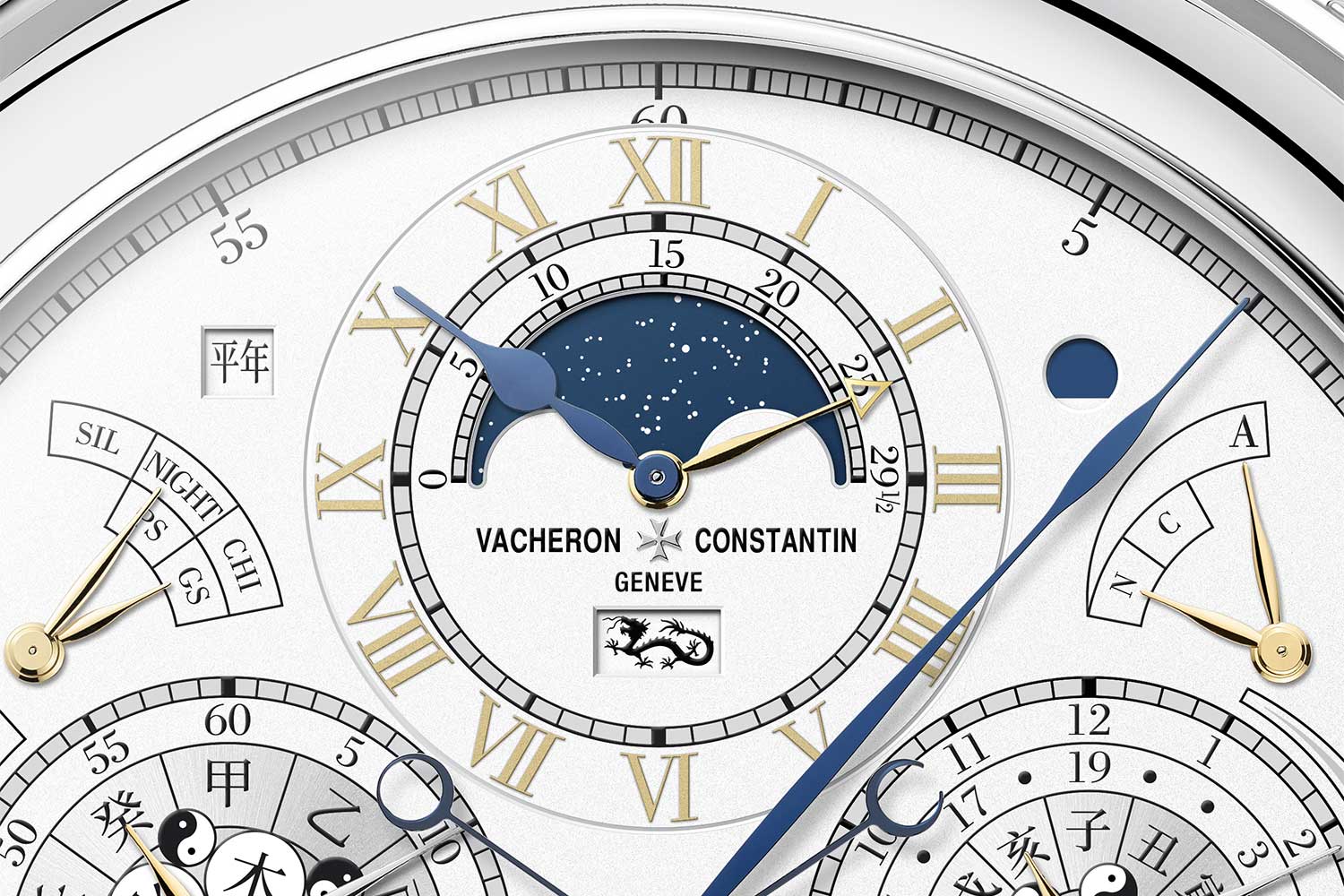
Vacheron Constantin Les Cabinotiers The Berkley Grand Complication
Like the reference 57260, The Berkley Grand Complication covers the full suite of chiming complications – a grande et petite sonnerie with minute repeater and a chiming alarm – with Westminster strikework, which reproduces the melody of the Big Ben clock on five gongs. The strike train can be set to either one of three modes, as is standard: grande sonnerie, which strikes the hours and the quarters in passing, petite sonnerie which strikes the full hours in passing, or silence. The alarm function is set by the crown and is displayed by an additional hour hand on the hour sub-dial. It is activated by a slide on the case middle at one o’clock and can be set to two modes: Carillon which chimes the melody of Westminster or normal mode which strikes the time on a single dedicated gong in a different tone. Notably, there is an additional ‘Night’ mode to deactivate the alarm between 10pm and 8am, which is a slot chosen by the client who commissioned the watch.
At the back of the watch is a Gregorian perpetual calendar that is mechanically linked to the Chinese calendar. The date is shown on a retrograde display at 12 o’clock, the day of the week on the sub-dial at three o’clock and the month at nine o’clock. There are also two tiny apertures at one and two o’clock for the leap year and the number of the day of the week respectively. The calendar display follows the rules outlined in ISO 8601, which is a standard established in 1988. ISO 8601 standardizes the date format for universal clarity and understanding across different countries and cultures and assigns a number to each week of the year (1 to 52), which is displayed on the right sub-dial co-axial to the month.
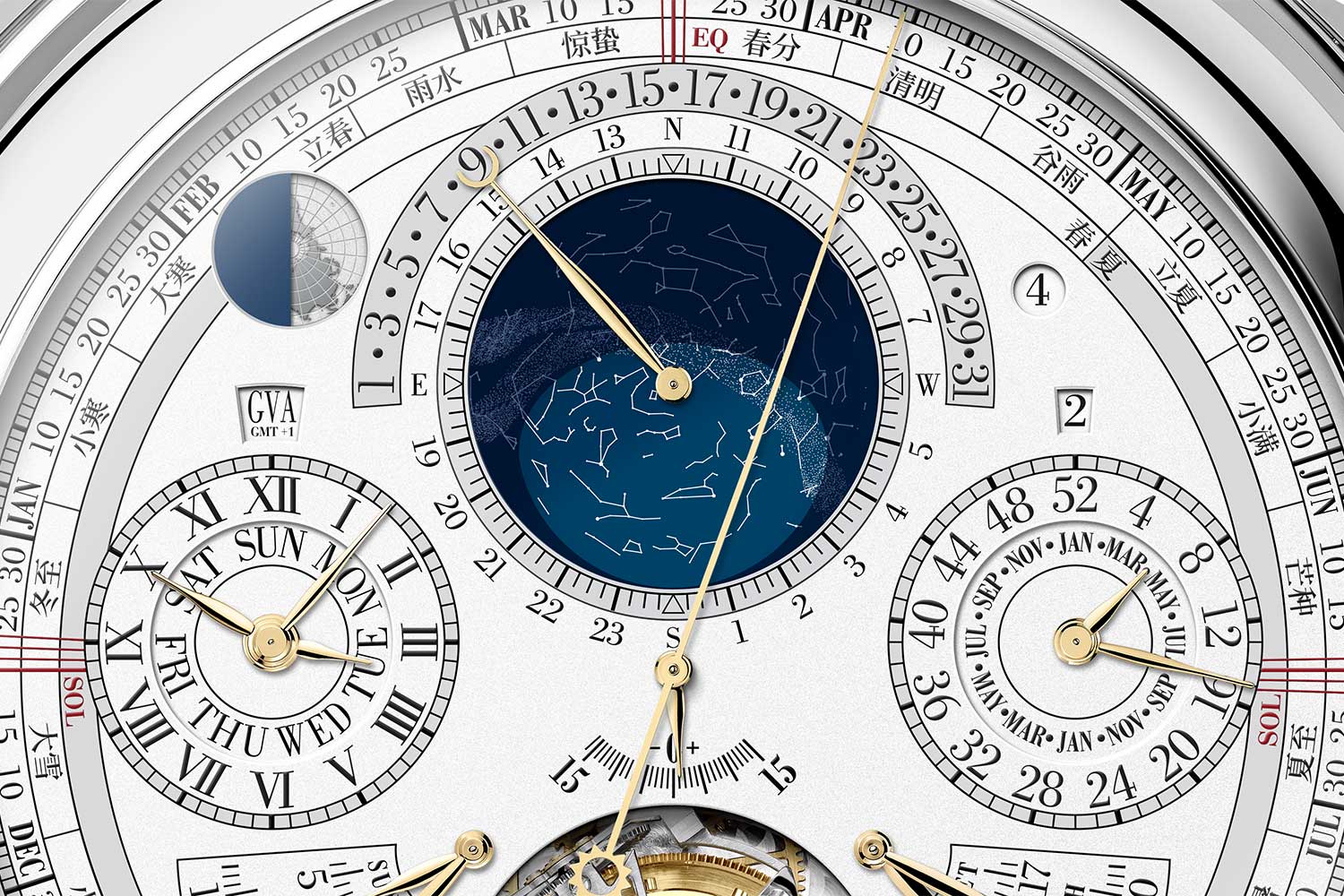
Vacheron Constantin Les Cabinotiers The Berkley Grand Complication
Right at the centre of the dial is an equation of time scale, which shows the difference between apparent solar time (sundial time) and mean solar time (clock time). This variation occurs because the Earth’s orbit around the Sun is not a perfect circle and because the Earth’s axis is tilted relative to its orbit. As a result, the Earth’s rotation speed and its orbital speed vary slightly throughout the year.
The equation of time quantifies this difference, showing whether the true solar time is ahead of or behind the mean solar time on any given day. This is expressed in minutes on the scale. There are also sunrise and sunset indicators below the counters, along with the lengths of day and night. As these values are latitude-specific, they have to be calibrated to the specific point on Earth where the owner is located in order to accurately reflect local sunrise and sunset times. At 12 o’clock is a star chart which shows the stars in the night sky in Shanghai in real time. An ellipse represents the viewing horizon directly overhead when looking at the night sky.
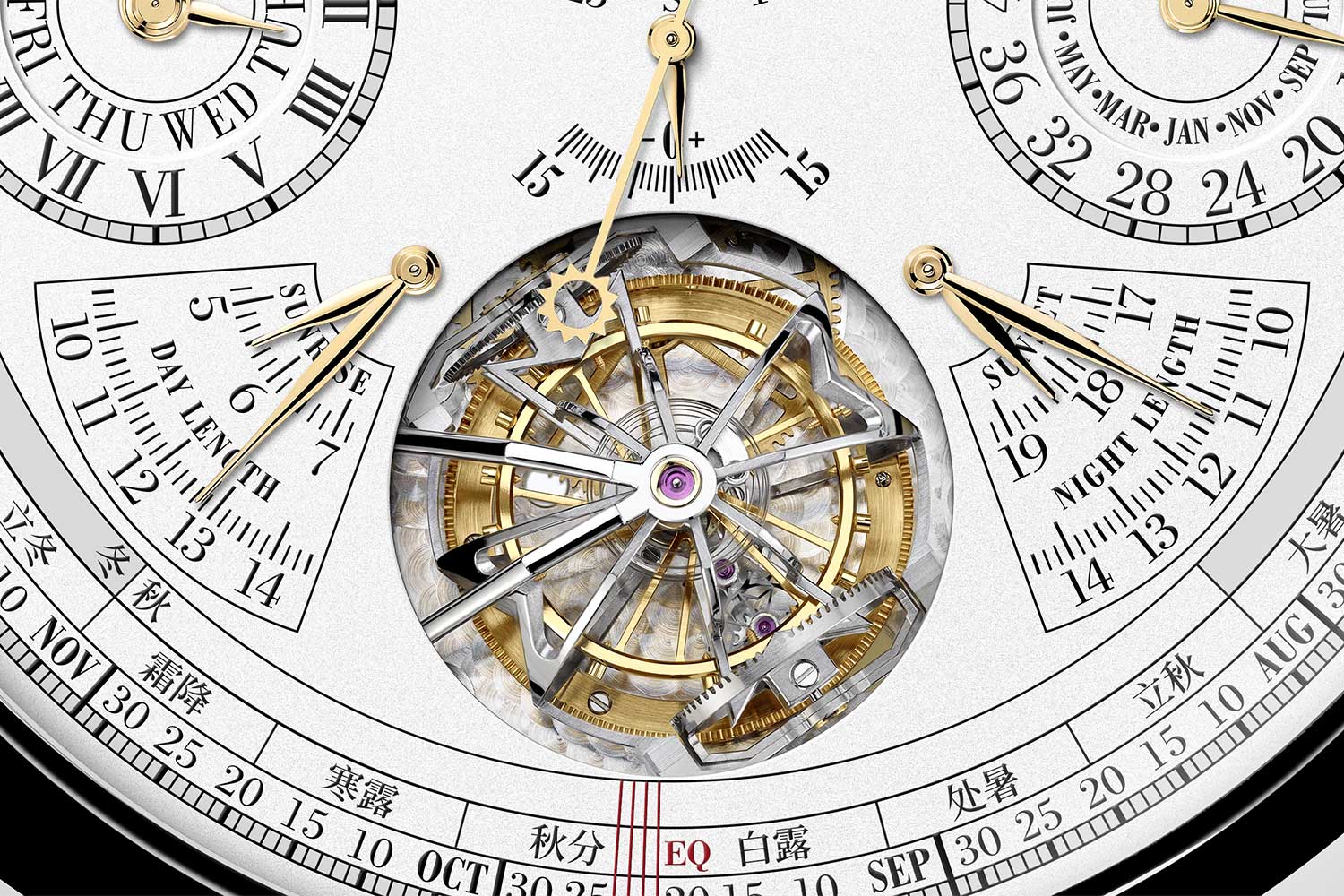
Vacheron Constantin Les Cabinotiers The Berkley Grand Complication
The star chart turns anticlockwise, the direction of motion for the stars when observed from the Northern hemisphere and completes one rotation in a sidereal day, the time it takes for a particular point on Earth to rotate once and return to the same position relative to the stars. Because the Earth not only rotates on its axis but also orbits the Sun, a sidereal day is slightly shorter than a solar day. It lasts approximately 23 hours, 56 minutes, and 4 seconds. The sidereal time can read on the 24-hour scale around the star chart.
There is also a world time indication for 24 cities, with the city name displayed in a window just above the nine o’clock counter with the time in the second time zone displayed in the nine o’clock sub dial. As it features a traditional 12-hour dial, there’s a day and night indicator positioned above the cities window.
On top of calendar, timing and chiming functions, The Berkley also incorporates a triple-axis armillary tourbillon like the reference 57260. Its design is intended to evoke an armillary sphere, an early astronomical device for representing the circles of the heavens. The armillary tourbillon has three cages with the outermost cage completing a rotating in one minute, during which two cages shaped like separate halves of a Maltese cross came together to form the cross every 15 seconds. All of that is meant to compensate for errors in rate due to gravity. It also houses a spherical hairspring, which enhances concentricity during oscillation, thereby minimizing radial forces and preserves isochronism.
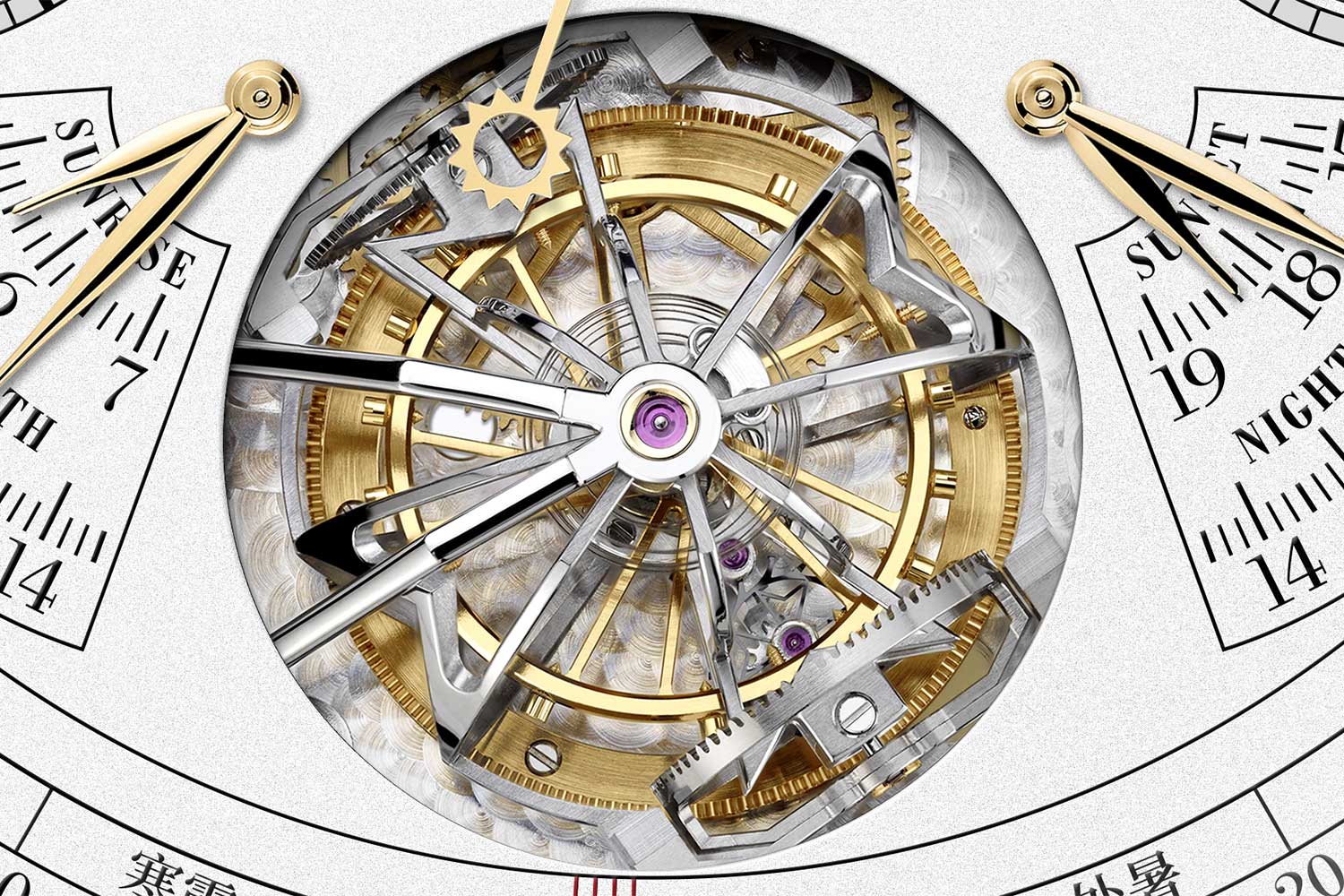
The triple-axis armillary tourbillon
While The Berkley shares numerous complications with the reference 57260, it is inarguably a monumental feat for achieving the unachievable to the best possible extent.
Full list of complications
Time measurement
1. Regulator-type hours, minutes and seconds for mean solar time
2. Retrograde second for mean solar time
3. Day and night indication for reference city
4. Visible spherical armillary tourbillon regulator with spherical balance spring 5. Armillary sphere tourbillon
6. World time indication for 24 cities
7. Second time zone hours and minutes (on 12 hours display)
8. Second time zone day and night indication
9. System to display the second time zone for the Northern or Southern
Hemispheres
Gregorian Perpetual Calendar
10. Gregorian perpetual calendar
11. Gregorian days of the week
12. Gregorian months
13. Gregorian retrograde date
14. Leap-year indication and four-year cycle
15. Number of the day of the week (ISO 8601 calendar)
16. Indication for the number of the week within the year (ISO 8601 calendar)
Chinese Perpetual Calendar
17. Chinese perpetual calendar
18. Chinese number of the day
19. Chinese name of the month
20. Chinese date indication
21. Chinese zodiac signs
22. 5 elements and 10 celestial stems
23. 6 energies and 12 earthly branches
24. Chinese year state (common or embolismic)
25. Month state (small or large)
26. Indication for the Golden number within the 19-year Metonic cycle
27. Indication for the date of the Chinese New Year in the Gregorian calendar
Chinese Agricultural Perpetual Calendar
28. Chinese agricultural perpetual calendar
29. Indications of seasons, equinoxes and solstices with solar hand
30. Sky chart (calibrated for Shanghai) 31. Sidereal hours
32. Sidereal minutes
33. Sunrise time (calibrated for Shanghai) 34. Sunset time (calibrated for Shanghai) 35. Equation of time
36. Length of the day (calibrated for Shanghai)
37. Length of the night (calibrated for Shanghai)
38. Phases and age of the moon, one correction every 1027 years
Split-seconds Chronograph (4)
39. Fifths of a second chronograph (1 column wheel)
40. Fifths of a second split-second chronograph (1 column wheel) 41. 12-hour counter (1 column wheel)
42. 60-minute counter
Alarm
43. Progressive alarm with single gong and hammer striking
44. Alarm strike / silence indicator
45. Choice of normal alarm or carillon striking alarm indicator 46. Alarm mechanism coupled to the carillon striking mechanism 47. Alarm striking with choice of grande or petite sonnerie
48. Alarm power-reserve indication
49. System to disengage the alarm barrel when fully wound
Westminster Carillon
50. Carillon Westminster chiming with 5 gongs and 5 hammers
51. Grande sonnerie passing strike
52. Petite sonnerie passing strike
53. Minute repeating
54. Night silence feature (between 22.00 and 08.00 hours – hours chosen by the owner)
55. System to disengage the striking barrel when fully wound
56. Indication for grande or petite sonnerie modes
57. Indication for silence / striking / night modes
Additional features
58. Power-reserve indication for the going train
59. Power-reserve indication for the striking train
60. Winding crown position indicator
61. Winding system for the double barrels
62. Hand-setting system with two positions and two directions
63. Concealed flush-fit winding crown for the alarm mechanism
Les Cabinotiers The Berkley Grand Complication 9901C/000G-B472Movement: Hand-wound Calibre 3752; 60-hour power reserve; 2.5 Hz or 18,000 vph
Case: 18K white gold; 98 mm in diameter by 50.55 mm thick; 960g
Dial: Metal; silvered opaline
Accessories: Delivered with a corrector pen & a magnifying glass
Piece unique, crafted on commission
















